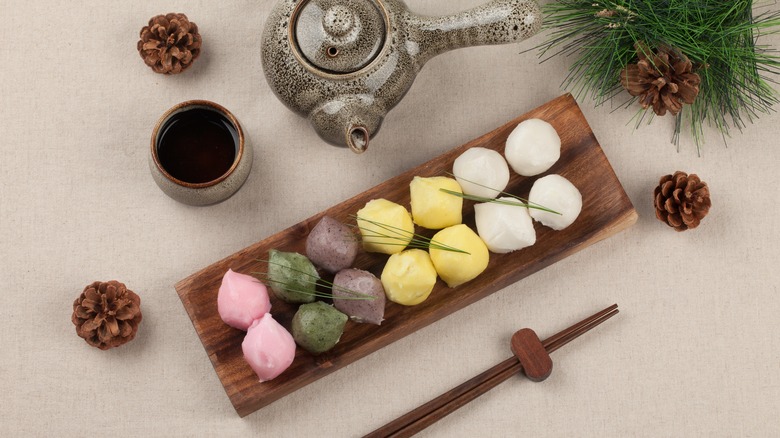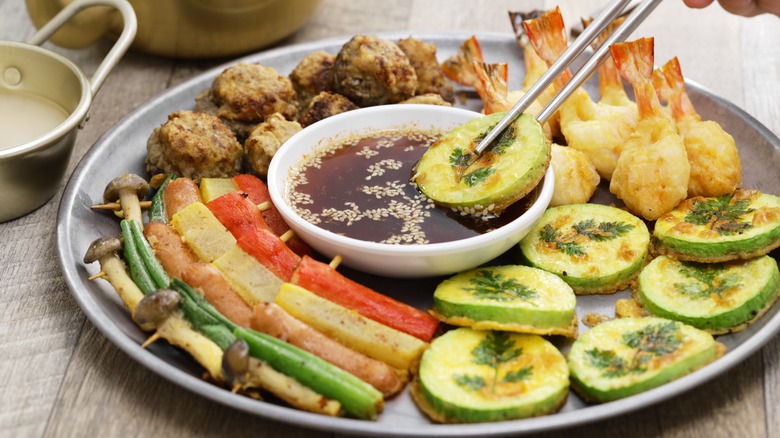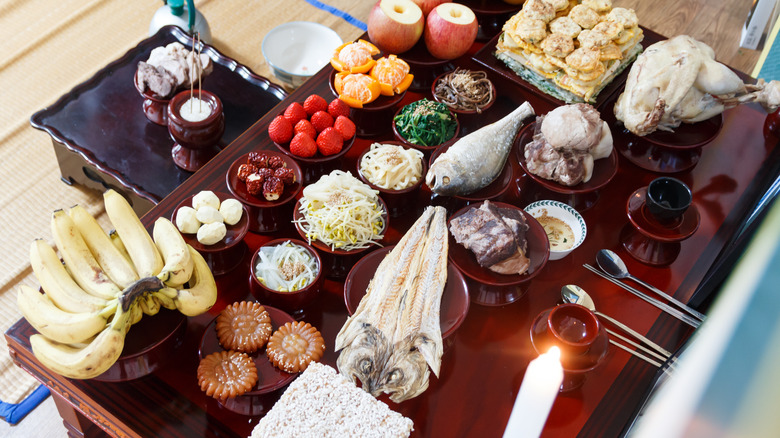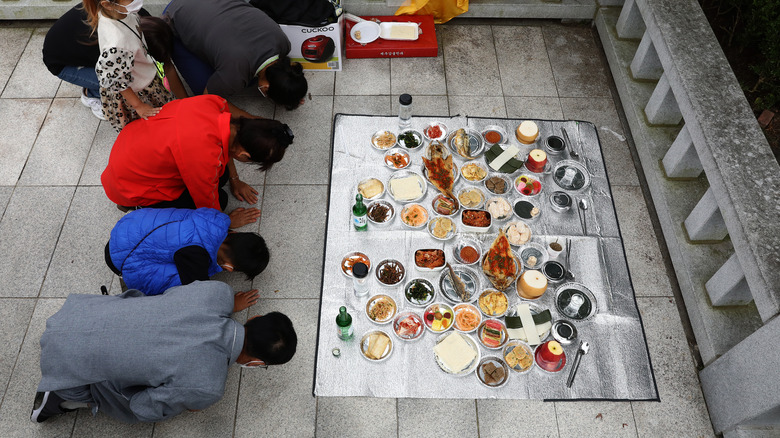Tips And Tricks For A Tasty Chuseok
Chuseok, also known as hangawi or Korean Thanksgiving, is a three-day celebration on the 15th day of the eighth month of the lunar calendar, which falls in September or October. It is uniquely Korean, but to those who are unfamiliar with the holiday, Chuseok is kind of like one part autumnal solstice, one part Dia de los Muertos, and one part American Thanksgiving.
Chuseok is a time when families come together, typically at the grandparent's or eldest son's home. People usually wear new clothes, bring gifts, and celebrate with a feast. Instead of turkey and gravy, Koreans eat a spread that includes foods like a rice flour dumpling called songpyeon, seasoned greens called namul, layered and skewered meats and vegetables in an egg batter called sanjeok, stir-fried sweet potato noodles called japchae, lots of fruits, alcohol, and an abundance of banchan that always includes a variety of kimchis. Koreans don't watch football but do like to gather around the television to watch a type of wrestling called ssireum.
While some people do make everything homemade, Chef Ji Hye Kim of Miss Kim in Ann Arbor, Michigan says that it is totally fine to buy some of these dishes ready-made, especially time-consuming songpyeon. Even in the United States, many of these dishes are readily accessible both fresh and frozen in cities where there are Korean markets.
What foods are eaten for Chuseok?
Without a doubt, songpyeon is the most iconic dish of Chuseok. These chewy, half-moon-shaped rice cakes are made with short-grain rice flour called ssalgaru or mepssalgaru. They are filled with sesame seeds, chestnuts, soybeans, red beans, mung beans, or pine nuts that are lightly sweetened with honey. Often the dough is left white, but they can also be dyed different colors like purple, red, and yellow. To cook, songpyeon are steamed with pine needles, imparting a unique aroma. Some say that the more beautiful your songpyeon, the more beautiful your future children will be. It is also said that songpyeon usher in prosperity for the eater. Songpyeon is both enjoyed by the living and offered to the dead.
For Chef Ji Hye Kim, Chuseok is about making something special to share with her extended family. She loves making a dish typical of the Gyeonggi province — where her mother is from — called nubiani. She describes this dish of soy, garlic, ginger, and sesame-seasoned grilled beef as "a sort of older, thicker sister of now more popular bulgogi." She also likes making torantang, a beef soup made with sweet and starchy fresh taro that is also popular on the holiday. Assorted pan-fried fritters called jeon also frequently appear on Chef Kim's Chuseok table because she can make them with whatever meats and vegetables she has available to her near her home in Michigan.
How to celebrate Chuseok outside of Korea
Perhaps you are Korean but live far from a Korean community, or maybe you are not Korean but are looking to understand this important holiday. The point of Chuseok is to give thanks for what you have, honor those who have come before you, and celebrate with loved ones over a traditional meal. If visiting the graves of family members isn't possible, making an ancestral table in honor of lost loved ones is still a meaningful way to celebrate the day.
Chuseok is the perfect time to make the trip you've been meaning to take to the next town over to visit that Korean market or restaurant. If you want to make typical Chuseok foods, but don't have access to a Korean store or Asian supermarket like H-Mart, Ji Hye Kim suggests visiting a Chinese grocery store instead as they may have some of those hard-to-find ingredients. Pan-Asian markets, Indian groceries, and even some Latin American stores may also carry what you need. Chef Kim is also a huge proponent of getting creative and adapting. She told Food Republic that, "the difficulty of sourcing less common ingredients sometimes is the reason why nubiani and jeon became my favorite dishes to make for Chuseok, as both dishes are made with ingredients that are not so unusual for an average family in, say, in the middle of Michigan."
Get creative, experiment, and use what you have locally to your advantage. You'll do just fine.
Honoring ancestors on Chuseok with altars and food
Chuseok follows the mid-autumn full moon, known elsewhere as the harvest moon. Indeed, Chuseok is a celebration of fall abundance, and Koreans traditionally use this time to give thanks to their ancestors for helping to bring in a generous harvest of summer crops.
Great importance is placed on a relationship with the ancestors, so Chuseok is also a time when Koreans build altars in their homes and visit the graves of loved ones. Offerings of special foods, fruit, and alcohol are made during Charye, which is celebrated on the first day of Chuseok. The same foods that are eaten and enjoyed by the family will be shared with the ancestors. Fruits like pears, apples, and persimmons are placed on the ancestral table and given special treatment — the tops of the fruits are sliced off so that the spirits of those who have passed on can easily enter them. For the ritual of Beolcho, Koreans tend to the graves of their family members by cleaning them and pulling any surrounding weeds. Flowers, food, and beverages are also left on the graves. Chuseok jal bonaeseyo — have a good Chuseok!




